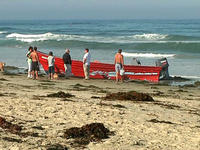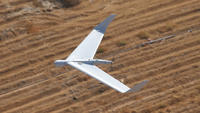-
Use of crime-fighting ShotSpotter technology to be expanded in Nassau County
For a year now Nassau County, New York, police department has been using the ShotSpotter system, and the country police commissioner says the department has been able to handle shootings much more swiftly, and that in certain instances lives might have been lost if it were not for the technology; the system records the number of shots fired, whether the shooter was stationary or moving, and provides audio playback of each gunshot event; this information not only provides situational awareness for law enforcement officers prior to arriving at the crime scene, but it is also offers valuable evidence for post crime analysis and legal proceedings
-
-
3-D mapping system recreate crime scenes
The technology allows law enforcement to take pictures, get accurate measurements, then put them into a computer to recreate a crime scene. The technology could be used in the courtroom to help jurors understand a case
-
-
NY DMV says facial recognition technology is working
The use by the State of New York DMV of facial recognition technology has been instrumental in identifying more than 1,000 cases of possible fraud, according to state officials; more than 100 felony arrests have been made so far, including an Egyptian citizen holding four New York licenses under separate names, one of which was on the federal “no-fly” list, and a former hit man who sought to establish a second identity after release from prison
-
-
Video arraignments saving time, money and improves safety for police, courts
In Michigan, police uses video arraignments via portable equipment at hospital bedsides, mental health facilities, local lockups, and county jails to save money and time, improve safety, and ensure suspects speedier justice
-
-
Tracking technology may make incarceration a thing of the past
The United States is facing a prison problem: there are many people in prisons — more than two million, a population the size of Houston; here is an idea: how about releasing most of them so they can lead productive lives — but make them wear something like the ExacuTrack from Anderson, Indiana-based BI Incorporated: the combination ankle bracelet and GPS transponder keeps real-time tabs on those who wear the gear, making sure they do what they are supposed to do and stay away from places where the state does not want them
-
-
Wolfhound sniffs out contraband cell phones
Wolfhound Cell Detector is a handheld, wireless sniffer specifically tuned to the RF signature of common cell phones; it helps universities, government and military installations, hospitals, law enforcement agencies, financial institutions, and prisons and correctional facilities enforce their No Wireless policies
-
-
Mexico to up security in border city after blasts
Following a series of explosions in downtown Reynosa, across the border from McAllen, Texas, the Mexican government is rushing reinforcements to the city; at the same time, thirty-five of the seventy-two bodies found in a mass grave on Saturday had been identified: sixteen Hondurans, thirteen Salvadorans, five Guatemalans, and a Brazilian; they were killed after refusing to cooperate with drug gangs
-
-
Drive-by full-body scanning
Massachusetts-based American Science & Engineering is selling van-mounted backscatter X-ray detection system to law enforcement; these vans can be driven past neighboring vehicles to see their contents
-
-
Police robot seeks out the bad guys
Police units in California use DHS grants to buy a robot to go into dangerous places to look for bad guys; the $12,000, 25-pound robot is waterproof, equipped with a 360-degree camera and tracks for movement; it climbs stairs, runs on grass and gravel, and can right itself if it flips over
-
-
Rayguns to be used in L.A. prisons
Officials at the Los Angeles County Jail have announced that the U.S. jails will deploy a new laser weapon to break up fights among jail inmates; the raygun, capable of producing a beam of up to 100 ft, will be positioned on the detention center’s ceiling and operated by using a computer monitor and a joystick
-
-
Businesses cope with Mexico security risks, pass costs to consumers
Faced with the threat of smuggling attempts by criminal organizations in Mexico, foreign companies are simply doing more, spending more, and in the process charging consumers more to shore up security in a country where killings, kidnappings, and extortions have become a part of daily life
-
-
New illegal immigration frontier: the sea

There is a new frontier for illegal immigrants entering the United States — a roughly 400-square-mile ocean expanse that stretches from a bullring on the shores of Tijuana, Mexico, to suburban Los Angeles; in growing numbers, migrants are gambling their lives at sea as land crossings become even more arduous and likely to end in arrest; while only a small fraction of border arrests are at sea; authorities say heightened enforcement on land, and a bigger fence are making the offshore route more attractive
-
-
Money smuggling across border grows despite increased enforcement
U.S. and Mexican law enforcement authorities only seize about 1 percent of cash from drug trafficking, despite increased efforts by both countries; stemming the flow of cash is vital to efforts by the United States and Mexico to take down drug cartels, as drug cartels depend on cash from wholesale drug sales to gangs in the United States
-
-
Mexico deploys Israeli UAVs in war on drug cartels

Since December 2006, nearly 30,000 Mexicans have been killed in that country’s increasingly vicious drug war; the relentless flow of guns from the United States into Mexico has significantly strengthened the drug cartels, allowing them not only to withstand the efforts by the Mexican authorities to impose law and order, but in many cases to take the operational initiative, making large swaths of the country ungovernable; the Mexican government, for its part, is bolstering its own capabilities: last year it has secretly purchased surveillance UAVs from Israel to perform monitoring tasks in border areas and near strategic installations in the country
-
-
Skeletal scans could be newest screening technique
The adult skeleton has 206 bones; size, shape, density, and joint structure make each skeleton slightly different; throw in an extra lumbar vertebrae or extra rib — which some people have — as well as previously broken bones, implants, screws, and other identifying characteristics, and the signatures become even more individual
-
- All
- Regional
- Water
- Biometrics
- Borders/Immig
- Business
- Cybersecurity
- Detection
- Disasters
- Government
- Infrastructure
- International
- Public health
- Public Safety
- Communication interoperabillity
- Emergency services
- Emergency medical services
- Fire
- First response
- IEDs
- Law Enforcement
- Law Enforcement Technology
- Military technology
- Nonlethal weapons
- Nuclear weapons
- Personal protection equipment
- Police
- Notification /alert systems
- Situational awareness
- Weapons systems
- Sci-Tech
- Sector Reports
- Surveillance
- Transportation
Advertising & Marketing: advertise@newswirepubs.com
Editorial: editor@newswirepubs.com
General: info@newswirepubs.com
2010-2011 © News Wire Publications, LLC News Wire Publications, LLC
220 Old Country Road | Suite 200 | Mineola | New York | 11501
Permissions and Policies
Editorial: editor@newswirepubs.com
General: info@newswirepubs.com
2010-2011 © News Wire Publications, LLC News Wire Publications, LLC
220 Old Country Road | Suite 200 | Mineola | New York | 11501
Permissions and Policies
